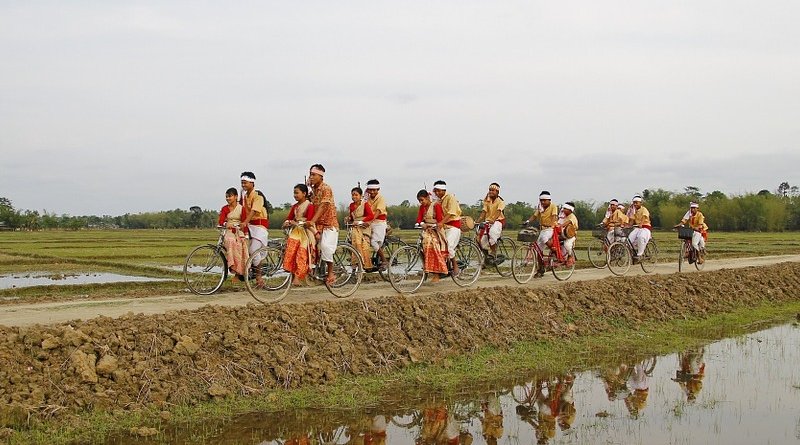India: The Gendered Impact Of The NRC In Assam – Analysis
By IPCS
By Akanksha Khullar*
The National Register of Citizens (NRC) is a mammoth exercise requiring individuals to prove their Indian citizenship through admissible documentation. So far, it has been conducted in Assam. The experience has demonstrated inherent structural flaws in the NRC that have disproportionately affected those from marginalised sections of society, especially women.
NRC: Structural and Social Impediments
In the NRC conducted in Assam, admissible documents included evidence of ancestry issued before 24 March 1971—such as mentions in the 1951 NRC and electoral rolls; land records; government-issued certificates; birth certificate; and educational certificates. Additionally, one is required to present evidence to prove one’s relationship with said ancestors. In this regard, limited knowledge of bureaucratic processes, low literacy levels, and patriarchy’s knock-down effects—i.e. factors that have a direct bearing on documentation culture—have impeded the ability of women in Assam to present such documentary evidence.
Marriage and Legacy Documents
As in other parts of India, in Assam, the numbers of registered marriages are considerably lower than the actual numbers of marriages that take place. According to Assam’s Cabinet Minister, Himanta Biswa Sarma, “Around three lakh marriages take place every year in Assam but only 50,000-60,000 are registered.” This could be attributed to a lack of awareness, compounded by limited socio-economic resources and low levels of literacy.
The NRC also requires individuals to provide documentation proving their relationship with their maternal/paternal families. This has caused several problems, particularly for married women, because, following set practice, many women (across diverse religious and ethnic groups) have replaced their maiden names with their husband’s surnames. To illustrate, in Assam, it is common practice among Muslim women to change their second names from ‘Khatun’ to ‘Begum’ upon marriage. In the Assam NRC, discrepancies in names (including in spelling) have affected how provenance of paternal family linkages is established, which in turn has led to exclusion from the final list.
In Assam—as in various other parts of the country—child marriage is still practiced despite being outlawed. Recent years have even seen a spike in such cases. Their registration (especially in cases where marriages took place several years ago) is thus a complicated issue.
As a remedial measure, in December 2017, India’s Supreme Court allowed Gram Panchayat-issuedcertificates to be accepted as a legitimate document for married women. While this enabled around 48 lakh such certificates to be submitted in Assam, on multiple occasions, NRC functionaries refused to accept its validity, presumably due to their own lack of awareness or confusion surrounding the process. Resultantly, several married women have been excluded from the NRC list.
Land Ownership
As is the case in most patriarchal and patrilineal societies, a bulk of women in Assam, especially those from disadvantaged sections of society, do not possess land. This rules out land records as valid documentation for these women. According to the National Family Health Survey, in 2015-2016, only 52.3 per cent of women in Assam owned a house and/or land (alone or jointly with others).As for agricultural land, 46,000 women (across all social groups) owned land totalling 53,000 ha.; 2000 (Scheduled Castes) owned 2000 ha.; and 11,000 (Scheduled Tribes) owned 13000 ha. Essentially, almost half the women in Assam could not utilise land ownership documents as evidence.
Educational Qualification Documents
Presenting documents pertaining to educational qualifications, too, have posed challenges. According to the 2011 census, 66.27 per cent of Assam’s approximately 12.8 million women were literate then. For the same year, only 13.2 per cent of approximately 1.1 million (Assam’s total female population; ages 14-17) were enrolled in grade 10, of which only 2.83 per cent were able to continue to grade 12. Similarly, only 12.6 per cent of approximately 1.8 million (Assam’s total female population; ages 18-23) were enrolled in undergraduate courses; .05 per cent in PG diploma courses; and.28 per cent in diploma courses. These numbers demonstrate the imbalance in women’s education levels, and point to various socio-economic realities—such as financial shortcomings, preferential treatment towards male children, etc.—that hinder women’s formal education. Consequently, the ratio of school or university degrees issued to women in Assam remains skewed.
Birth Certificates
Gaps in birth registration practices in Assam (much like in the rest of India) also exist. A birth being recorded does not automatically mean registration, leading then to certification, of the birth. Moreover, even registration does not automatically guarantee that those persons possess evidence in the form of a birth certificate. While this affects both men and women, the latter were disproportionately affected during Assam’s NRC process because it compounded other documentary impediments.
Conclusion
The NRC exercise in Assam demonstrates the process’ failure to take into consideration the gendered nature of society in Assam, as well as the process’ gendered impact. The disproportionate and pernicious effect of this process on women includes exposure to a much higher risk of being rendered stateless, and to their fates being left to the mercy of Foreigners Tribunals that are quasi-judicial bodies. In addition to remedying these gaps in Assam, New Delhi must take into account the lessons learnt if it envisions undertaking the NRC nation-wide.
*Akanksha Khullar is a Researcher at the Centre for Internal and Regional Security at IPCS.

